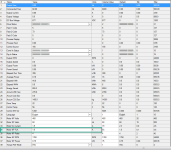I think this may have caused some confusion with the OL setting. Current Limit in a VFD is not the same as Over Load.
MOTOR OVERLOAD protection should be set at the motor FLA.
Current Limit can be set higher. But the VFD has its own limits and in a PF525, it is 150% of the VFD rating for 60 seconds, 180% for 3 seconds. The mention of 110% for 60 seconds for "Normal Duty" only applies to drives that are sized as such, and that is only done at 25 and 30HP drives (@ 480V). In the PF525, when you program a Current Limit setting, the drive will override your Accel setting to keep the current down, so you have to be aware of that.
There is an internal "Hardware Current trip" that is hard coded to protect the transistors at 180% in no more than 3 seconds, or 300% instantaneously, that is NOT programmable. You CAN set the motor OL to be 200%, but don't expect it to deliver that for more than about 1 second.
In addition there is Stall fault and a thermal limit to the VFD, so if you attempt to hang out in Current Limit for too long, you will trip it on Stall Fault or overheat the drive and trip it on Over Temperature, then have to wait for it to cool down. Doing this repeatedly is one way to kill a VFD as well.





